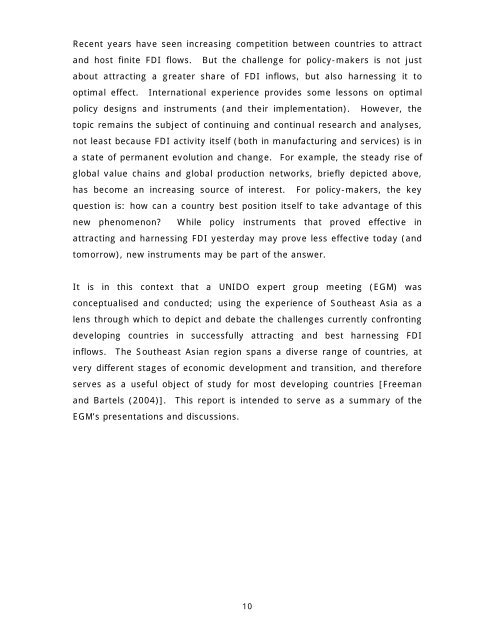(EGM) Foreign Direct Investment in Southeast Asia - Unido
(EGM) Foreign Direct Investment in Southeast Asia - Unido
(EGM) Foreign Direct Investment in Southeast Asia - Unido
Create successful ePaper yourself
Turn your PDF publications into a flip-book with our unique Google optimized e-Paper software.
Recent years have seen <strong>in</strong>creas<strong>in</strong>g competition between countries to attract<br />
and host f<strong>in</strong>ite FDI flows. But the challenge for policy-makers is not just<br />
about attract<strong>in</strong>g a greater share of FDI <strong>in</strong>flows, but also harness<strong>in</strong>g it to<br />
optimal effect. International experience provides some lessons on optimal<br />
policy designs and <strong>in</strong>struments (and their implementation). However, the<br />
topic rema<strong>in</strong>s the subject of cont<strong>in</strong>u<strong>in</strong>g and cont<strong>in</strong>ual research and analyses,<br />
not least because FDI activity itself (both <strong>in</strong> manufactur<strong>in</strong>g and services) is <strong>in</strong><br />
a state of permanent evolution and change. For example, the steady rise of<br />
global value cha<strong>in</strong>s and global production networks, briefly depicted above,<br />
has become an <strong>in</strong>creas<strong>in</strong>g source of <strong>in</strong>terest. For policy-makers, the key<br />
question is: how can a country best position itself to take advantage of this<br />
new phenomenon? While policy <strong>in</strong>struments that proved effective <strong>in</strong><br />
attract<strong>in</strong>g and harness<strong>in</strong>g FDI yesterday may prove less effective today (and<br />
tomorrow), new <strong>in</strong>struments may be part of the answer.<br />
It is <strong>in</strong> this context that a UNIDO expert group meet<strong>in</strong>g (<strong>EGM</strong>) was<br />
conceptualised and conducted; us<strong>in</strong>g the experience of <strong>Southeast</strong> <strong>Asia</strong> as a<br />
lens through which to depict and debate the challenges currently confront<strong>in</strong>g<br />
develop<strong>in</strong>g countries <strong>in</strong> successfully attract<strong>in</strong>g and best harness<strong>in</strong>g FDI<br />
<strong>in</strong>flows. The <strong>Southeast</strong> <strong>Asia</strong>n region spans a diverse range of countries, at<br />
very different stages of economic development and transition, and therefore<br />
serves as a useful object of study for most develop<strong>in</strong>g countries [Freeman<br />
and Bartels (2004)]. This report is <strong>in</strong>tended to serve as a summary of the<br />
<strong>EGM</strong>’s presentations and discussions.<br />
10

















